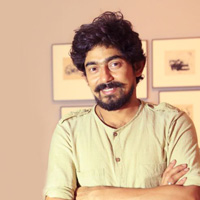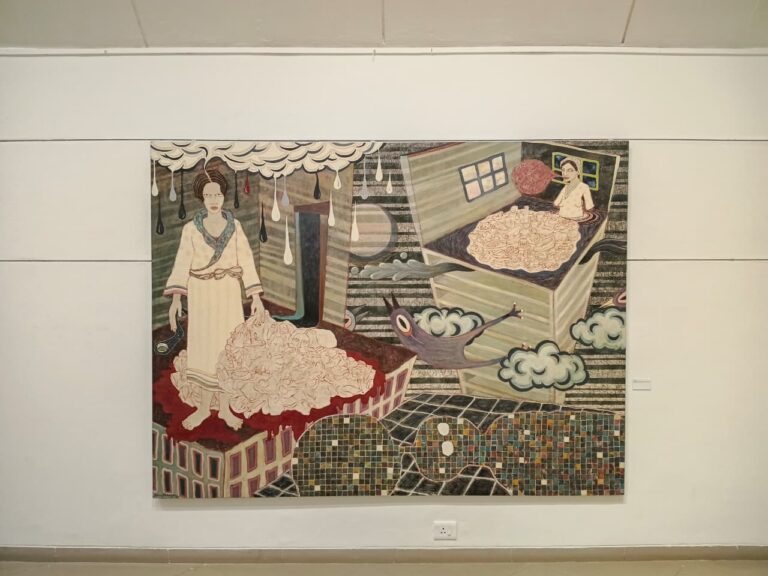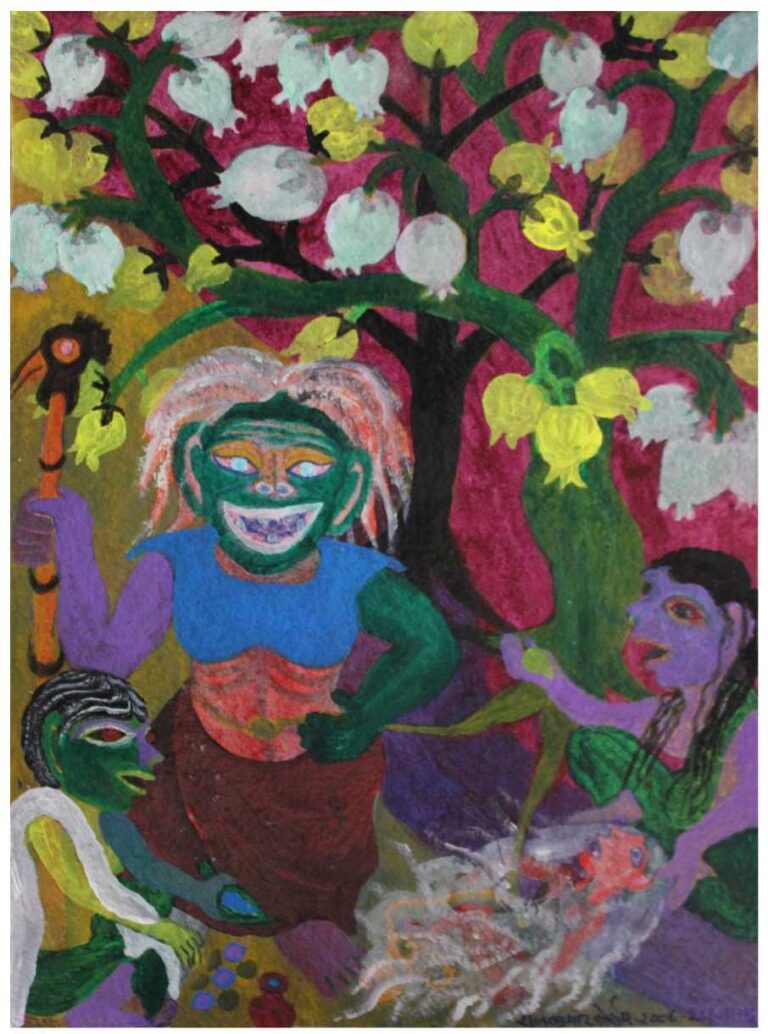Kafka’s The Burrow tells us the story of a wounded person caught in tension between the self and the world. The protagonist digs a burrow and tries to hide the physical and metaphorical self and body from the gaze of the world. Since then, the burrow has been dug by many in the most obvious and unexpected ways. Somehow many of those burrows find themselves in a labyrinth of connections through an underground maze. Since the beginning of the last century, the body has been made into an unusual register in everything from literature to visual arts, from performance to films, from academia to civil society. While curating ‘MEWE – Locating the Individual within the Movement’, Myna Mukherjee has brought together works from 25 artists that populate a vivid and coherent landscape of expressions. These works not just create a dialogue between the viewer and the viewed, but also spark conversations between the artworks themselves.

In these distressed times of renewed censorship, Myna who has previously curated several shows around the politics of representation, has yet again chosen to show works which on one hand we may be quite comfortable with in a private setting, but putting such works in public requires a reconfiguration of the ‘expected’ in a gallery space. Incidentally the show took place in the ‘underground space’ of the American Centre, New Delhi. This daring yet aesthetic take on individual illustration of queerness may be termed as the underground self unearthed!
The visual experience of a viewer is not restricted by books on art history. The spectacular does attract human attention and imagination with or without the knowledge of art history. As a result, curators like artists have now started including components that were not regarded as art in the yesteryears. ‘MEWE’ is a coming-of-age of an art show for these very reasons. Myna has illustrated the human experience of the ‘queerness’ beyond the ‘available’ in visual arts, she has roped in different perspectives of crafting a visual canon of ‘queerness’.

In last few decades academics have contributed and created the cannon of queer theory. Since 1990 when Professor Teresa de Lauretis coined the term, the ‘queer’ has itself evolved. ‘MEWE’ is a show that plays around the widest definition of the term queerness. This show, somehow addresses the cause of breaking the very monolithic notion of queerness.
Queerness is typically non-heteronormative, non-patriarchal and anarchist in terms of aesthetics. It is unfair to look for a stereotype while trying to understand the idea of queerness just as it is foolish to look just to the sexual while attempting to define ‘queer’. The ‘queer’ here is constructed of multiplicity of its own remote location within the self. Somehow this exhibition brings together the millions of shades that lie between the meta-colours of the proud rainbow flag of the queer community.
The concept of the spectacular is independent from that of the ‘artwork’. In a shiny world of plastic, fluorescent colours and LED screens, how does one catch the viewers’ attention? ‘MEWE’ starts its discourse on a wall that is made of carmine red, where Valay Gada’s pricked tongue reminds us of the censorship of these times while being flanked by two sets of works by Nikhil Bansal on each side that contains the serenity and is reminiscent of Gustav Klimt’s visual language.

While accessing the main gallery space, one comes across a video-text installation and GIF derived from the location of queerness in media and personal lives. Three asymmetric perforated frames preserve the electrically colourful and fluid riot of dreams and fantasy created by Satadru Sovan. While accessing the main exhibition space from the stairs, one can see two works of Sonia Khurana in animated postures that can be interpreted as that of a Soprano. Now just to spill the beans, do you remember the Franco-Belgian traveller Alexandra David Neel? She was an opera singer. She refused to have kids, she refused to become what others wanted her to become, she is an epitome of a certain kind of queerness. Or do you remember the castrati secrets of Naples’ noble families? Then it might make sense of how these works refer to queerness.

Four works of Balbir Krishan and two photographs of Ram Rahman debate between the queer that emanates between the fragile drawings of ink, pen and colour, and public iconography of gender and fantasy. Framing the opposite wall, Gopa Trivedi’s large canvas with a forlorn empty swing speak of the experience of feeling othered and unbelonging to previously familiar and safe spaces like home. Two photo-performances of Manmeet Devgun indicate the heteronormative concept of language and the sexual domination by masculinity. ‘Making love’ becomes the dream life of angels and ‘violation’ becomes the reality. Just next to Manmeet’s is the work of Amir which portrays an unusual intimate scene between those men who live in the pigeon hole of megacities. Another one of his works on the opposite wall depicts two men kissing, which could have been renamed as More Than a Kiss after Philippe Doisneau’s emblematic work on the subject. Ipshita Thakur’s Egon Schiele inspired illustrations take on autoerotica to reclaim pleasure as personal and firmly devoid of the gaze.
Young North Eastern artist Baishali’s visual language is conventional and touching in appearance yet her subjects are explosive. One of her untitled mixed media works shows the impossible togetherness of queerness in neat and geometric forms. A series of drawings, pen and ink and watercolours bring forth the individual expressions of lust, intimacy, desire and annihilation in the register of Myna’s take on queerness. However, celebration, fun, game-playing and the chase are not excluded either. One set of works by Mohan Jangid inspired by Japanese manga hints at India’s obsession with the global erotic language, while some other works by next generation artists like Renu Sharma capture the cosmic narrative texture of Enki Bilal. These create the spectrum of the queer experience as happy yet non-achievable, extravagant yet lonely. Similarly the photo-performances and photo collages of Inder Salim and Pulkit Mogha respectively sample the same texture of aloneness. Inder Salim’s well-known work Inder and Salim plays around the physiognomic currency that can be converted and camouflaged.

Other notable works include illustrations from public art expressionists like Gargi Chandola, site installations by fashion designer Sumiran Kabir Sharma of gender fluid label ANAAM and Indira Lakshmi Prasad, mixed media book works with a take on invisibilities in history by Dinesh, intimate watercolours and queer fantasia by Aditya Raj, and graphic and comic book panels by Oddbench and Hypagirl.
This show comes at the intersection of two major quadrants, queerness and probable visual expression of the individual self. With human eyes experiencing the 3D movies, can desire drive our creative self to overcome the loudness of heteronormative technology-driven societal visual culture and create a counter aesthetics? In judiciary ‘benefit of doubt’, an often used term, is a legal provision that gives space to the so-called ‘convicts to escape’. This shows even before making a statement of purpose, all it demands is the ‘benefit of doubt’ one must accord to the queerness instead of decrying the ‘expected’.

The journey of queerness began long before it was identified. In last century, from the cafes of Saint-Germain-des-Prés a young bunch of artists and anarchists tried to voice the unheard, and later got labelled as Dada etc. In Woodstock, attempts were made to make queer the new-normal. The fight for basic human expression is on in every country, within and without the state, within or without the society, within or without the self. In the present political context, ‘MEWE’ puts together many of the Me’s that may or may not be able to stand the test and taste of time and regimes, perhaps! Artworks that we see are maybe the me’s that have already ceased to exist in the deep layers of the self in a temporal and bodily sense. Queer may not be that strange in our world, we just try to make it look more awkward than it is. The excavation of the Self may reveal the queer that was dormant since the archaeological times!
![]()
This show was an ancillary event to amplify the joint efforts by 34 embassies in New Delhi to further equal rights on the occasion of International Pride Month. It was presented as a joint collaboration between Engendered, a transnational arts and human rights organization and the American Embassy in New Delhi. It was heartening to see one of India’s premier hotel chain The Lalit endorse it in continuation of its support of the cause of equal rights.
All image courtesy: The curator.














